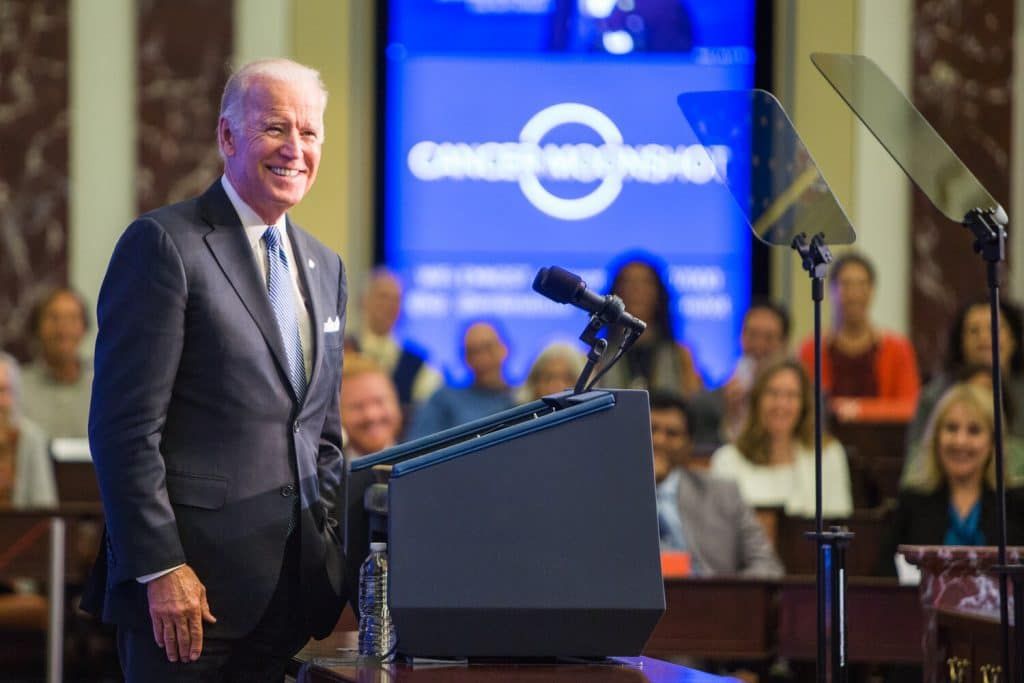A clean return to the Iran nuclear deal should be Biden’s first option
By Eric Brewer | January 11, 2021
 Joe Biden. Photo credit: Eric Haynes.
Joe Biden. Photo credit: Eric Haynes.
Of all the international agreements President-elect Joe Biden has pledged to rejoin upon taking office, perhaps none is more controversial than the Iran nuclear deal, also known as the Joint Comprehensive Plan of Action. Although the deal was containing Iran’s program until Trump withdrew in mid-2018—a move that led Iran to ramp up its nuclear activities—some are now arguing that returning to the deal isn’t a good idea or is too difficult given developments over the last four years.
This is unfortunate. Returning to the deal is not only viable but also presents the best chance of preventing an Iranian bomb. It is the best path toward building on the agreement and addressing some of the shortfalls that critics deride. Moreover, with a bit of planning, the Biden team could address several key concerns about the US return.
Arguments against rejoining the deal: Sorting the good from the bad. Some of the arguments and policy prescriptions offered by skeptics of returning to the deal are not realistic and should be dismissed. For example, some favor increasing pressure on Iran until that country’s leaders make more concessions on nuclear and non-nuclear activities. But no amount of pressure alone will cause Iran to abandon its ballistic missile program entirely or cease its support to terrorist groups, militias, and other malign non-state actors. Those policies are central to Iran’s concepts of national security and defense and ending them would require dramatic changes to the region and Iran’s threat perceptions, at a minimum. The past four years has demonstrated that extreme pressure and unrealistic demands only cause Iran to increase its nuclear program and regional aggression.
But other critiques of returning to the deal have some merit and deserve consideration. A well-planned attempt at a “clean return”—in which the United States and Iran follow a series of agreed steps that bring them back into compliance to the deal’s original terms—would address many of them.
These objections can be broken down into three categories—strategy, process, and politics.
Objections to strategy. Some argue that it makes little sense to rejoin the deal because restrictions on Iran have already expired or would expire in the next few years, and that giving Iran significant sanctions relief would yield important leverage that could help secure a follow-on deal.
In fact, rejoining the agreement would put the United States in a stronger position to address both of these concerns. By returning, Washington would immediately cease to be the problematic actor—global attention would shift back toward Iran. This would make it easier for the United States to work with the international community to limit the fallout from the expired conventional arms embargo and to plan for the lifting of restrictions on Iran’s missile program, slated to occur in October 2023. A Biden team would then have the remainder of its first term to make progress toward a new deal (or deals) that addresses Iran’s nuclear and non-nuclear activities—long before the most important sunsets kick in. (The limits on enrichment levels and Iran’s stockpile of uranium, which are key to maintaining longer breakout timelines, don’t expire until 2031 and many of the monitoring provisions last even longer).
The United States still has ample incentives it can offer Iran in negotiations for a follow-on deal. These range from further assistance for Iran’s civil nuclear program, to relaxing the US trade embargo, to taking steps to help Iran actually reap the economic benefits of sanctions relief. (Recall that Iranian officials were quite dissatisfied that the removal of sanctions under the deal did not translate into the economic gains they expected or advertised.) And if and when talks expand to include missile and other regional issues, this will likely involve other players in the region that can put additional incentives on the table.
Concerns about process. Another set of concerns focuses on the process of returning to the agreement. Skeptics claim there simply just isn’t enough time. Biden will be inaugurated January 20, and Iranian President Hassan Rouhani will be out of office less than six months later, likely replaced by a more hardline successor. Potentially further complicating a swift return by both sides, Iran has hinted that it may insist on US compensation for its withdrawal from the deal; and it will expect Washington to remove sanctions first before dialing back its program.
True, the United States and Iran would have to act quickly to agree on the process by which both come back into compliance, but there are reasons to believe it might work. Both sides want to get it done. Iranian officials have been fairly consistent that they would be willing to return to compliance if the United States does the same. The new law recently passed by Iran’s parliament that requires Iran to gradually increase its nuclear activities and reduce inspections—while a risky gambit on Iran’s part—also creates an incentive for both sides to act early. This also won’t be the first rodeo for either side. Given that the Biden team has brought on several former Obama administration officials that helped reach the nuclear deal with the Rouhani administration in 2015, there is a good chance that these negotiating teams will once again be able to find a compromise on how to sequence a return to compliance—and do so in a way that assuages concerns about who returns “first.”
Relatedly, the fear that a US–Iran deal hammered out in Rouhani’s remaining days would be abandoned by a more hardline Iranian President has it backward: A mutual return in the first half of 2021 would actually put a future Iranian administration in a bind. It would force it to leave the revived agreement—and all of the economic and political risks that entails—rather than simply upping the ante to force a harder bargain, with the United States already being out. Moreover, Iranian Supreme Leader Ali Khamenei—not the president—will be the one who makes the ultimate call on Iran’s commitments.
Finally, it is an open question whether Iran would actually ask for compensation if offered a US return, and therefore something Washington can and should test. Khamenei has been relatively quiet on this issue, and what he has said suggests that such compensation can be pushed off to a later date. Further, the United States may be able to dissuade Iran from making new demands by threatening to counter with its own set of issues, such as Iran’s progress on advanced centrifuge research and development—knowledge and experience that can’t easily be undone. Iran’s desire for compensation isn’t about money, it’s about political optics. As a result, there’s a good chance a face-saving compromise can be reached.
Fears of political costs. Concerns in this category include many of the above—sunsets are too close, the window for return is too short, the deal doesn’t address other Iran issues, and leverage will be lost—with the worry that trying to return quickly will alienate Israel, Saudi Arabia, and other Gulf partners. The belief among this group—which includes some Democrats—is that these problems make the political costs of return exceedingly high. It may be fine to reach a smaller interim deal to stop Iran’s nuclear expansion, but US domestic political realities dictate that returning to the 2015 agreement isn’t viable or wise. Or so the argument goes.
There are a few problems with this argument. First, a new, broader deal—or an interim “freeze for freeze” toward such a deal—would require Iran and the United States to reach a new bargain, whereas the 2015 agreement is something that all parties already know and have endorsed and implemented before. Crafting a new agreement is easier said than done, as each would want to avoid yielding too much leverage. Second, unlike the 2013 interim predecessor to the 2015 deal—known as the Joint Plan of Action—which was reachable in part because progress toward a comprehensive deal was being made, an interim deal now would likely be done out of recognition that a return or a bigger deal were unlikely in the foreseeable future. To date, Iran has rejected this type of bargain, and it is at best unclear if Tehran would be open to it in the future.
A Biden administration could also take several steps to address concerns that a clean return would let up pressure on other Iranian problematic activities or hang regional allies out to dry. This includes developing plans to manage other aspects of its Iran policy and engaging Congress, Israel, and Gulf partners. First, while the United States might need to reverse some of Trump’s sanctions against Iran’s non-nuclear activities, it does not need to reverse them all. The administration should develop a serious and specific plan to deal with Iranian missile developments and its provision of weapons to militias and other non-state actors. The Trump administration has increased US efforts to combat these threats through interdictions and other measures, and a Biden administration should continue them and find ways to improve. And it should commit to doing so in close coordination with Israel, Saudi Arabia, and other Gulf states.
In addition, while it works out the details of a clean return with Iran, the United States should also seek to gain Iranian buy-in for follow-on talks—once both sides return to the deal—that build on the nuclear agreement and include other contentious issues. While it would be nice to get firm and specific Iranian commitments on issues such as extending sunsets now, Washington needs to be realistic. Any statement would likely need to be kept vague given that there would not be time or political will on either side to hash out specifics. And the United States would stand a better chance of getting Iran on board through quiet diplomacy rather than publicly framing this as a US red line. But even in-principle commitments to improve upon the deal or to discuss “regional security issues” could be an important signal that in short order talks would commence to address issues that both parties identify as a concern. This—combined with the unilateral measures outlined above—may help assuage concerns among critics, particularly in Congress, that such issues would fall by the wayside once the 2015 nuclear deal comes back online.
The option of first resort. It remains to be seen whether the United States and Iran will be able to build on the nuclear deal. Doing so will be incredibly difficult—more difficult than the original agreement. The Trump pathway of pulling out of the deal and trying to bully Iran into a bigger bargain failed to produce success. So it is worth trying the alternative of rejoining the deal as a first step.
The United States should pursue a return to the deal as an option of first resort on the merits alone. But even if it doesn’t succeed—for example, if Iran rejects the US offer of a clean return—Washington will be far better positioned to pivot to alternatives, to include a smaller deal or maintaining pressure. In that scenario, trying and failing would at least flip the script of the last four years: Iran would be the intransigent party, and the United States would be better able to work with the international community to address the challenges posed by Iran.
The views expressed in this publication are solely the author’s and do not imply endorsement by the Office of the Director of National Intelligence, the intelligence community, or any other US government agency.
Together, we make the world safer.
The Bulletin elevates expert voices above the noise. But as an independent nonprofit organization, our operations depend on the support of readers like you. Help us continue to deliver quality journalism that holds leaders accountable. Your support of our work at any level is important. In return, we promise our coverage will be understandable, influential, vigilant, solution-oriented, and fair-minded. Together we can make a difference.
Keywords: Iran, Iran nuclear deal, JCPOA, Joe Biden, sanctions
Topics: Analysis, Nuclear Risk
















The article is so one sided that it has little chance of success. A successful agreement involves taking into account the view point of the opposing side. Iran has learnt the hard way that lifting of a few sanctions gets them no benefits. There are so many sanctions that even when one is removed, there is another one which covers the same issue. The layers of sanctions existed even under Obama and have become more complex under Pompeo. Apart from this is the fact that any revived JCPOA would be short lived. It has no chance of being passed by… Read more »